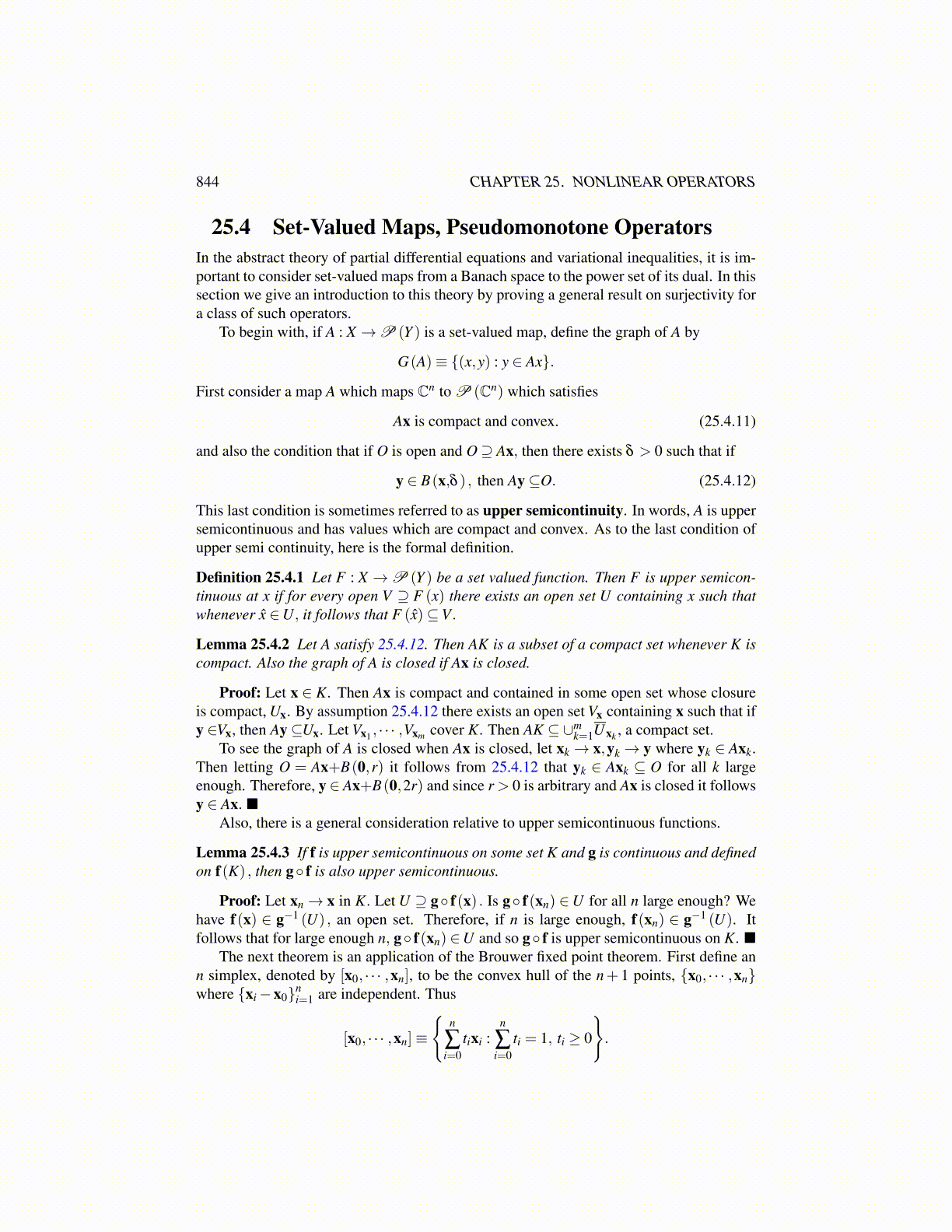
844 CHAPTER 25. NONLINEAR OPERATORS
25.4 Set-Valued Maps, Pseudomonotone OperatorsIn the abstract theory of partial differential equations and variational inequalities, it is im-portant to consider set-valued maps from a Banach space to the power set of its dual. In thissection we give an introduction to this theory by proving a general result on surjectivity fora class of such operators.
To begin with, if A : X →P (Y ) is a set-valued map, define the graph of A by
G(A)≡ {(x,y) : y ∈ Ax}.
First consider a map A which maps Cn to P (Cn) which satisfies
Ax is compact and convex. (25.4.11)
and also the condition that if O is open and O⊇ Ax, then there exists δ > 0 such that if
y ∈ B(x,δ ) , then Ay⊆O. (25.4.12)
This last condition is sometimes referred to as upper semicontinuity. In words, A is uppersemicontinuous and has values which are compact and convex. As to the last condition ofupper semi continuity, here is the formal definition.
Definition 25.4.1 Let F : X →P (Y ) be a set valued function. Then F is upper semicon-tinuous at x if for every open V ⊇ F (x) there exists an open set U containing x such thatwhenever x̂ ∈U, it follows that F (x̂)⊆V .
Lemma 25.4.2 Let A satisfy 25.4.12. Then AK is a subset of a compact set whenever K iscompact. Also the graph of A is closed if Ax is closed.
Proof: Let x ∈ K. Then Ax is compact and contained in some open set whose closureis compact, Ux. By assumption 25.4.12 there exists an open set Vx containing x such that ify ∈Vx, then Ay⊆Ux. Let Vx1 , · · · ,Vxm cover K. Then AK ⊆ ∪m
k=1Uxk , a compact set.To see the graph of A is closed when Ax is closed, let xk → x,yk → y where yk ∈ Axk.
Then letting O = Ax+B(0,r) it follows from 25.4.12 that yk ∈ Axk ⊆ O for all k largeenough. Therefore, y∈ Ax+B(0,2r) and since r > 0 is arbitrary and Ax is closed it followsy ∈ Ax.
Also, there is a general consideration relative to upper semicontinuous functions.
Lemma 25.4.3 If f is upper semicontinuous on some set K and g is continuous and definedon f(K) , then g◦ f is also upper semicontinuous.
Proof: Let xn→ x in K. Let U ⊇ g◦ f(x) . Is g◦ f(xn) ∈U for all n large enough? Wehave f(x) ∈ g−1 (U) , an open set. Therefore, if n is large enough, f(xn) ∈ g−1 (U). Itfollows that for large enough n, g◦ f(xn) ∈U and so g◦ f is upper semicontinuous on K.
The next theorem is an application of the Brouwer fixed point theorem. First define ann simplex, denoted by [x0, · · · ,xn], to be the convex hull of the n+ 1 points, {x0, · · · ,xn}where {xi−x0}n
i=1 are independent. Thus
[x0, · · · ,xn]≡
{n
∑i=0
tixi :n
∑i=0
ti = 1, ti ≥ 0
}.